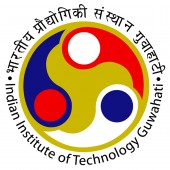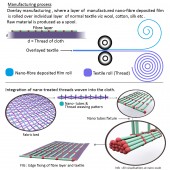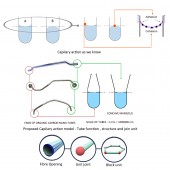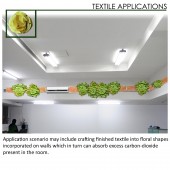DESIGN NAME:
Bio-inspired fabric
PRIMARY FUNCTION:
Textile
INSPIRATION:
Nature as a teacher, Bio-inspiration, Bio mimicry
UNIQUE PROPERTIES / PROJECT DESCRIPTION:
Can coil and uncoil upon human touch inspired from memosa-pudica, can absorb carbon form from atmosphere based on the features of leaves and artificial photosynthesis and chances of providing water at locations where oxygen is less but exposure to sunlight is possible.
Thoughts on the project :
• Leaves inspired structures in human environment
• Developed textile that can function like leaves
• Fiber optimization
Ideas on the project :
A curtain that can carry out photosynthesis
A curtain that coils back when just touched
A textile that can help regenerate fuels in fuel cells
A textile that can supply necessity to body at
extreme condition
OPERATION / FLOW / INTERACTION:
Thoughts on the project :
• Leaves inspired structures in human environment
• Developed textile that can function like leaves
• Fiber optimization
Ideas on the project :
A curtain that can carry out photosynthesis
A curtain that coils back when just touched
A textile that can help regenerate fuels in fuel cells
A textile that can supply necessity to body at
extreme condition
PROJECT DURATION AND LOCATION:
Duration : Six months (One semester)
Location : Department of Design, Indian Institute of technology, Guwahati, Assam, India
FITS BEST INTO CATEGORY:
Building Materials and Construction Components Design
|
PRODUCTION / REALIZATION TECHNOLOGY:
Principles :
• Capillary action
• Coil and recoil
• Artificial Photosynthesis
Capillary Action :
• Adhesion of water molecules
• Surface Tension of water
• Less than 1 mm diameter
Coil and recoil :
• Mimosa Pudica,Venus Fly trap
• motor cells
• Turgor pressure
• Hinges (Pulvini) at base of the stalk
• external stimuli.
• Extensor , Flexor
• sensory hair
Artificial Photosynthesis :
Includes four basic steps
Step 1 - A way to harvest the solar energy, or light from the sun
• Organic photovoltaic.
• Imitate the natural process by using material analogous to chlorophyll.
• captures the light and then passes the photons on to the next step.
• digital fabrication technique such as a nano form of continuous deposition
Artificial Photosynthesis :
Step 2- Mimicking the process by which the plant uses the photon to split the water molecule into hydrogen and oxygen.
• It takes about 2.5 volts to break a single water molecule down into oxygen along with negatively charged electrons and positively charged protons.
• Organic cells are light in weight and thin in structure helping to make nano pieces.
• Most efficient in terms of turning energy into electricity.
• Fabricating the films and paths for the photons to pass through and follow.
• Bio mimetic refers to human-made processes, substances, devices, or systems that imitate nature.
Artificial Photosynthesis :
Step 3- Mimicking the “bio- energy” transfer that occurs because of ATP and NADPH
• Important protein in the process is Rubisco, which actually waterproofs the reaction site which is selective for carbon dioxide.
• Be fabricated into an object or circuit done constantly under a nano- fabber.
• Genetically altered Rubisco .
Artificial Photosynthesis :
Step 4- Converting the carbon dioxide into other products.
Setup :
• A fabber to manufacture the nanotube that sucks in the air,
• the nano solar panel that takes in the light,
• The chemical dispenser that is added to the mix for a chemical reaction of CO2 and O2 and energy or food,
• An output tube,
Overlay Manufacturing of the Nano-fiber film where normal textile thread is rolled over with a layer of Nano-fiber deposited film roll , and the final textile is produced as a spool.
Nano capillary tube capability : It can continue to carry fluid as a result of capillary action and there is no obstruction to the transportation of the fluid as nano-tubes are free from any risk of leakage.
SPECIFICATIONS / TECHNICAL PROPERTIES:
-
TAGS:
Bio-inspiration, Bio-design
RESEARCH ABSTRACT:
This project on adaptaive textile intends to deal and understand basic and advance phenomenon found in natural systems and their articulation and implementation in artificial systems. The primary objective is to understand the principles first, realize opportunities and later try to implement them at a level feasible to be understood , explained and applied .
All theories and principles of bio-inspiration are truely extraordinary and an attempt to implement them at an artificial level through design thinking is also among the main objective of this semester project.
CHALLENGE:
TITLE
Adaptive textile based on bio-inspiration.
Summary : The project undertaken here is an understanding of the various application mankind will adhere to for betterment of humanity, and this in particular deals with natural processes and how to incorporate them in artificial systems in order to restore sustainability to an extent so that mankind is beneficial. An understanding of biological systems and their functioning has been undergone to deduce concept designs and ideas further on.
ADDED DATE:
2011-08-04 08:07:10
TEAM MEMBERS (2) :
Rajatesh Nath Barbhuiya and Pradeep Yammiyavar
IMAGE CREDITS:
Rajatesh Nath Barbhuiya, 2011.
|









